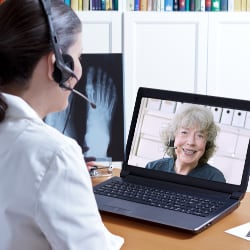
The Advantages of Virtual Healthcare
Over the past year, due to COVID-19, virtual healthcare has taken the world by storm. Telemedicine offers many people a chance to receive virtual medical support.

The Advantages of Virtual Healthcare
Over the past year, due to COVID-19, virtual healthcare has taken the world by storm. Telemedicine offers many people a chance to receive virtual medical support.
Virtual healthcare can be much safer than in-person visits. Older individuals or those with immune deficiencies can stay healthier with telemedicine.
But the benefits of virtual healthcare don't stop there! Televisits for behavioral health conditions have also been on the rise.
According to one CDC survey, about 41% of adults in the US reported feelings of depression or anxiety last year.
Many of these individuals have benefited from virtual visits. These might include meeting with a therapist or psychiatrist.
Even after the pandemic, many experts predict that virtual healthcare will stick around. Telemedicine is easy and convenient. So it's an attractive option for the future of healthcare.
In this post, you'll learn more about different options for virtual healthcare. You'll also get a chance to explore the exciting benefits that telemedicine has to offer.
Keep reading to find out more about this expanding field of medicine!
What Is Telemedicine?
During the pandemic, telemedicine has made it easier and safer to get the medical care you need. Virtual healthcare has also expanded medical care in remote areas.
Before we review the benefits of telemedicine, let's learn a bit more about what this field includes.
There are many different technologies used in telemedicine. Some technologies monitor patients from a distance. Others provide real-time virtual services.
Let's review some of these different technologies now:
Real-Time Virtual Healthcare
You might be most familiar with these virtual televisits. Real-time visits use audio and video technology to conduct a healthcare assessment.
Most virtual visits take place with a doctor or a nurse practitioner. Medical providers ask questions and conduct visual inspections.
In general, these visits should be used for minor illnesses like a cold or a brief pregnancy check-up. For more serious conditions, patients should visit urgent care centers or emergency rooms.
Here are some conditions suitable for real-time virtual visits:
- Pink eye
- A sprain or a muscle strain
- Allergy-like symptoms
- Poison ivy rashes or similar skin issues
- Bug bites or stings
- Urinary tract infections
Your provider will start by asking you about specific symptoms. At the end of the visit, they can prescribe medication or recommend other options.
Store and Forward Technology
This virtual healthcare option allows your provider to capture information or images. The provider will then forward these materials to a specialist for review.
Your doctor might choose this option to share your health records with another provider.
This is especially common in rural areas. Store and forward options help your doctor get specialized advice and recommendations.
If you live far away from the proper specialist, store and forward could make all the difference.
Monitoring Patients Remotely
In certain cases, your medical provider might want to monitor your health signs. They can do this virtually using telemedicine.
If you have diabetes, for example, your doctor might give you a wearable device to track your blood glucose. Your doctor can follow any sudden changes in real-time.
Doctors can also use this information to notice patterns in your health. This can help doctors create targeted treatment options for you.
Other wearables track:
- Changes in heart rate
- Altered or unsteady walking patterns
- Issues with posture
- Seizures or tremors
- Sleeping habits
- Rates of physical activity
You might also use a mobile app to store information for your doctor. Certain medical apps send health information directly to your provider. Your provider can then analyze this information and share it with other providers.
Some doctors also offer chatbot options. These automated medical chatbots can give you targeted medical advice through a chat session.
For some patients, a chatbot is a great option for days when you don't have time for an entire televisit.
Of course, every patient's case is unique. No one telehealth option is right for every patient and condition. But the right telemedicine tool could have a positive impact on your present and future health.
And remember, there are always more options for healthy living! Making healthy choices that fit your lifestyle is always the best way to go.
Let's take a look at some further benefits of telemedicine now.
Benefits of Virtual Healthcare
Virtual healthcare can make it easier to get the care you need quickly. Televisits and remote monitoring devices can also make you feel more confident about your health from day to day.
But the benefits of virtual healthcare extend even further! Let's examine these now.
Raises Quality of Your Care
Telemedicine can make treating patients faster. Patients who are treated quickly are more likely to benefit from their providers' care.
Wait times at urgent care centers and emergency rooms can be overwhelming. A virtual provider can advise you on whether you need urgent or emergency care.
Many patients report feeling happier and more comfortable with their providers after a televisit.
Improves Patient Engagement
Busy patients can fit a televisit between work meetings or family time. The convenience of virtual healthcare makes it more likely that patients will engage.
When patients feel engaged with their providers, this creates a sense of trust over time. Doctors with engaged patients can identify illnesses in earlier stages. They can also encourage preventative medicine.
Reduces Overall Costs
Virtual healthcare saves money for both patients and medical providers. For conditions that aren't serious, patients can save the money they would spend on emergency copays.
Doctors who use telemedicine can also see more patients in a shorter period. When providers can conduct virtual visits, their medical practice also earns more money.
A condition can be treated during a televisit before it becomes serious. In this case, the patient might not require more invasive care. Treating conditions early on also saves money for doctors and patients.
Helps More Patients
Many patients do not have access to a primary care physician. They might not have regular transportation. Or they might not be mobile enough to make the trip on their own.
Virtual healthcare can reach patients from the comfort of their own homes. This increases the number of patients that doctors can help.
In other cases, patients might not live near a medical specialist they need. Their local doctor can use virtual conferencing to consult specialized providers.
This can help patients get the specialized care for their specific condition. And they won't have to deal with the expense and inconvenience of a long trip.
Does Telemedicine Have Any Cons?
In general, telemedicine improves healthcare for doctors and patients. But there are certain limitations to telemedicine benefits.
For example, there are many laws governing patients' medical privacy. Sharing private information through technology can put that information at risk.
Providers using this technology should make sure they follow the proper legal requirements. They should also ensure that private information is protected.
When a provider decides to use telemedicine, this can also cause some roadblocks. All staff who will be using telemedicine must be trained.
The process of training or retraining staff members can be time-consuming. But the upfront effort will ultimately pay off for patients and providers.
Another limitation of telemedicine has to do with getting continuous care. Many patients benefit from seeing the same doctor each visit.
In virtual healthcare, you can choose from many different providers located all around the country. Patients who use televisits might be seeing a range of different providers.
This could make it harder for patients to feel engaged with their medical providers.
But with digital health records, doctors can share medical information immediately. A patient might see a larger number of doctors. But they will all have access to the same medical information.
Looking Ahead
Virtual healthcare is beneficial for many patients who might not access care otherwise. But telemedicine will not be a complete substitute for in-person medical care.
Moving forward, providers will likely recommend telemedicine in addition to in-person treatment.
They might monitor conditions like diabetes remotely. But they would also want to follow up on this monitoring with physical checkups.
Telemedicine has played an important role during COVID-19. It has made healthcare easier and more accessible than ever before.
In the years to come, virtual healthcare will certainly stick around. Telemedicine promises to improve the long-term health of many individuals.
Take Charge of Your Health Today
As any doctor will tell you, the best medicine is always prevention.
Virtual healthcare can make it easier to get the medical treatment you need. But taking care of your body every day is also crucial.
SupplementRelief.com is a family-owned business committed to your health. Our expert staff is dedicated to helping all our clients meet their wellness goals.
Are you interested in learning more about how you can take charge of your health today? Then get in touch! We look forward to welcoming you into our community of well-being.

Jay Todtenbier is an original founder of SupplementRelief.com in 2010 and has operated the business ever since. He is also a tennis instructor and gospel musician. Formerly he spent 25 years in business development, technology and marketing with startups and major corporations having gone through the tech boom in Silicon Valley in the 90s. He became passionate about, and began studying and practicing Wellness as a Lifestyle after experiencing chronic, personal health challenges including depression, auto-immune disorders, and being overweight that impacted his ability to live a healthy, vibrant life. Since then, he has been an advocate for healthier living encouraging others to live better through making small, gradual changes to lifestyle behaviors relating to whole-foods nutrition, stress management, reasonable exercise, proper sleep, and the use of targeted, high-quality supplements.
Learn more about Jay Todtenbier.
-
 Discussion Forum
Questions or Feedback?
Discussion Forum
Questions or Feedback?Ask questions. Share your thoughts. Note that we cannot answer questions relating to specific medical conditions - please refer those to your qualified healthcare provider.
Post a new Comment or Reply to an existing one. Help for using the Discussion Forum.
 Discussion Forum Help
Discussion Forum Help
Comments are displayed in order of the last one posted so the most recent one is at the top and the oldest one at the bottom.
Replies within a Comment are displayed in reverse order with the oldest one at the top and the most recent one at the bottom.
Each post identifies
 who made the post and the
who made the post and the  date and time the post was made.
date and time the post was made.Mouse over the icons for tooltips that explain what they mean.

If you see this icon you can attach an Audio file to your post.

If you see this icon you can attach a Document file to your post.

If you see this icon you can attach an Image file to your post.

If you see this icon you can attach a Video file to your post.
You will see the
 Ban icon (Report Post as SPAM) immediately following the Timestamp of the post. Click this icon if you feel strongly that the content posted is not appropriate and should be reviewed by the Forum Moderator. You will be provided with a confirmation dialog to be sure you wish to submit this post for review. If submitted, the Forum Moderator will be notified to review the post and will determine what type of action to take.
Ban icon (Report Post as SPAM) immediately following the Timestamp of the post. Click this icon if you feel strongly that the content posted is not appropriate and should be reviewed by the Forum Moderator. You will be provided with a confirmation dialog to be sure you wish to submit this post for review. If submitted, the Forum Moderator will be notified to review the post and will determine what type of action to take.Click
 in the upper right corner of this Help modal or anywhere on the web page outside of the modal to exit Help.
in the upper right corner of this Help modal or anywhere on the web page outside of the modal to exit Help.
![]() Session Expired from Inactivity
Session Expired from Inactivity
Do you want to?
9618 Jefferson Highway, Suite D-191
Baton Rouge LA 70809-9636
(888) 424-0032 |
support@supplementrelief.com
* Disclaimer: This page is available exclusively for SupplementRelief.com clients. None of the information on this website is intended to replace your relationship with your healthcare provider(s). Nothing should be considered medical advice. The information, knowledge, and experience shared on this website are the opinions of SupplementRelief.com. This site and its content are intended to enhance your knowledge base as YOU MAKE YOUR OWN HEALTHCARE DECISIONS in partnership with your qualified health professional.
* These statements have not been evaluated by the Food and Drug Administration. These products and services are not intended to diagnose, treat, cure, or prevent disease.
* There is NO GUARANTEE OF SPECIFIC RESULTS for the products or services offered, and the RESULTS CAN VARY for each individual. Any results claimed by our customers are based on individual experiences that are unique and cannot be guaranteed.
FirstFitness Nutrition and NuMedica may be promoted and sold on the internet ONLY by Authorized Resellers who have been approved by and have registered their website domain with these companies. They strictly prohibit, and actively monitor, the UNAUTHORIZED SALE or RESALE of their products in ALL online public shopping portals including Amazon, eBay, and others and into other countries. All products purchased in SupplementRelief.com are for PERSONAL USE ONLY and CANNOT BE RESOLD to others. Please report violations of Reseller Policy directly to FirstFitness Nutrition at 800.621.4348 and to NuMedica at 800.869.8100.
The content and photographs on this website are copyrighted or Licensed Material and may not be downloaded for other than personal use. Republication, retransmission, reproduction, or any other use of the content or photographs is prohibited. ©2010-2024 SupplementRelief.com.
Are you sure you want to remove this item?

